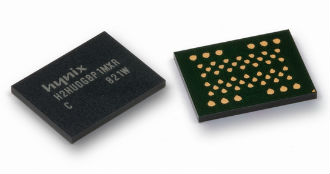 Capital spending by semiconductor companies grew by 12.9 percent last year, but will only grow by 0.8 percent this year.
Capital spending by semiconductor companies grew by 12.9 percent last year, but will only grow by 0.8 percent this year.
 Capital spending by semiconductor companies grew by 12.9 percent last year, but will only grow by 0.8 percent this year.
Capital spending by semiconductor companies grew by 12.9 percent last year, but will only grow by 0.8 percent this year.
 The European Semiconductor Industry Association (EISA) released data for November 2014 which showed sales were up by 3.4 percent compared to the same month a year before.
The European Semiconductor Industry Association (EISA) released data for November 2014 which showed sales were up by 3.4 percent compared to the same month a year before.
 Intel has hit the market with a range of faster Core M chips which are hitting the shops just a few months after its first Core M lineup was announced.
Intel has hit the market with a range of faster Core M chips which are hitting the shops just a few months after its first Core M lineup was announced.
Intel has added four more Core M’s to its list. Like the launch chips, these four are dual-core designs that support HyperThreading. Like the earlier chips, these are spec’d with a TDP of 4.5W.
However, these are faster than the launch models, with a base clock speed of 1.2GHz, which is burstable through Turbo up to 2.9GHz.
What really sets these chips apart from the initial Core M models is that their TDP is scalable, based on what the builder wants to do with it. For example if the chip is set to be used in a notebook with very little free space, the OEM could opt to drop the chip down to 3.5W and lose 600MHz in the process. A bulkier notebook could handle a hotter chip better, so a higher TDP can be used. Any one of these new chips could be tweaked to peak at 6W and add 200MHz to the clock. That would put a chip like the M-5Y71 at 1.4GHz, rather than 1.2GHz.
The chips also offer the same flexibility for graphics. The IGP in the initial Core M chips were clocked at 100MHz base, while these new CPUs start at 300MHz. The top-end clock for the top two models can reach 900MHz, whereas some of the launch models peak at 850MHz.
All four of these new models have officially launched, but it is likely that they will not hit the market until early 2015.
 US traffic cops (CHiPs) have been using mobile search laws to steal naked pictures of hot women they er pull over.
US traffic cops (CHiPs) have been using mobile search laws to steal naked pictures of hot women they er pull over.
According to an East Bay California Highway Patrol officer, accused of stealing nude photos of a DUI suspect claimed officers have stolen images for years.
Officer Sean Harrington of Martinez confessed to stealing explicit photos from the suspect’s phone, and said he forwarded those images to at least two other CHP officers.
Harrington called the photo stealing a “game” and said he had done the same thing to female arrestees a “half dozen times in the last several years.”
His reasoning is that others were doing it so why should he be the only one punished.
Photos were discovered missing when a suspect said she synced her phone after her arrest and noticed when six photos were sent from her phone to another account.
Richard Madsen, the victim’s attorney said that the pictures were private and should not be seen by anyone.
In a written statement to KPIX 5, CHP Commissioner Joseph Farrow said, “The allegations anger and disgust me. We expect the highest levels of integrity and moral strength from everyone in the California Highway Patrol and there is no place in our organization for such behaviour.”
What would Ponch say?
 Things are on the turn in the chip business, and it’s a turn for the better.
Things are on the turn in the chip business, and it’s a turn for the better.
The European Semiconductor Industry Association (ESIA) said today that sales hit $3.231 billion in August, that’s up 10.9 percent compared to August last year.
Its figures represent a three month rolling average.
ESIA said the logic market was pretty strong – that continues a trend that emerged early this year. MOS (metal oxide semiconductor) based microprocessors grew strongly compared to July. And flash and NAND memory also showed good performance compared to July.
The chip market is, of course, affected by exchange rates with trading in Euro and in dollars affecting the mix. But, nevertheless, in August this year semi sales were 2.393 billion Euro – which represents a 0.4 percent decrease over July, said ESIA.
ESIA is bullish. It said worldwide sales for August 2014 amounted to a not insignificant $28.435 billion – up 9.4 percent compared to August 2013, and up 1.3 percent compared to July 2014.
 Qualcomm, under investigation for possible monopolistic practices in China, said it had no direct financial links with an antitrust expert.
Qualcomm, under investigation for possible monopolistic practices in China, said it had no direct financial links with an antitrust expert.
Zhang Xinzhu, a member of the Chinese Academy of Social Sciences (CASS) and one of China’s leading antitrust experts was sacked from a government advisory post after state media reported he had received payments from Qualcomm.
Qualcomm is being investigated by the National Development and Reform Commission (NDRC), one of China’s three antitrust regulators, over how the company licenses its patents and prices its chipsets.
The chipmaker did not hire Zhang directly. When it was investigated by the NDRC it hired Global Economics Group to produce an economic analysis for submission to the regulator. Global Economics Group employed Zhang Xinzhu.
The official Xinhua News Agency reported on Wednesday that Zhang had been fired from the State Council’s expert commission on competition issues for taking “huge rewards” from Qualcomm. The implication was that Qualcomm had been bribing Zhang to suggest that the regulators should be nice to the American chipmaker.
Qualcomm paid Global Economics its standard rates for the firm’s services,” Trimble said, and did not have “any financial dealings” with Zhang directly.
Qualcomm’s analysis was submitted to the NDRC in May and had three principal authors, including Zhang.
The Chinese said that Zhang had “contravened work discipline” and been removed from his position on the anti-monopoly committee.
The news agency said “certain multinational companies” had been attempting to delay antitrust probes, including spending money to gain support on experts groups and complaining of being picked on for being foreign.
“Against this backdrop, hiring relevant ‘experts’ from government departments to ‘speak on behalf of foreign companies’ is a violation of discipline … This matter should be gotten to the bottom of and bought to light,” Xinhua said.
The 21-member anti-monopoly academic experts group from which Zhang was dismissed was established in 2011. The group is seen to serve the principal role of providing the bureaucracy with the supporting arguments needed to justify its industrial policy aims.
But Zhang has been critical of the NDRC, and claimed that the regulator had acted outside of its jurisdiction and misused antitrust principles. It appears that the regulator, might just want him out of the way.
 Nvidia posted higher second-quarter earnings and gave a forecast for current-quarter revenues that exceeded what the cocaine nose jobs of Wall Street predicted.
Nvidia posted higher second-quarter earnings and gave a forecast for current-quarter revenues that exceeded what the cocaine nose jobs of Wall Street predicted.
This was surprising given that some analysts were worried that PC shipments were flat in the June quarter.
Nvidia’s graphics chips for PCs make up most of its business but what appears to have saved the company’s bottom line was that it has been selling to car makers and data centres.
In the second quarter, revenue from Tegra chips for automobiles and mobile devices jumped 200 percent to $159 million.
After struggling to compete against larger chipmakers like Qualcomm in smartphones and tablets, Nvidia has increased its focus on using its Tegra chips to power entertainment and navigation systems in cars made by companies including Volkswagen’s Audi, BMW and Tesla.
Nvidia in July launched its own tablet aimed at game enthusiasts, called Shield, with Tegra chips and other high-end components. This went against the industry trend toward commoditized, inexpensive devices.
Nvidia has been doing well in the cloud by flogging its chips to IBM, Dell and HP as part of their datacentre product range.
Predictions are that Nvidia’s GRID graphics technology for data centres will also do well after it has been tested by other potential enterprise customers.
Nvidia reported second-quarter revenue of $1.1 billion, up 13 percent from the year-ago quarter as it expanded its focus on cars and cloud-computing.
For the current quarter, Nvidia said it expects revenue of $1.2 billion, plus or minus 2 percent. Analysts on average expected second-quarter revenue of $1.1 billion and third-quarter revenue of $1.16 billion.
Nvidia’s net income in the second quarter, which ended on July 27, added up to $128 million or compared with $96 million in the year-ago quarter.
 AMD thinks it can get back into the portable console business, and is hinting at a new deal with Nintendo involving its 3DS.
AMD thinks it can get back into the portable console business, and is hinting at a new deal with Nintendo involving its 3DS.
The vice president of AMD’s custom semiconductor business Saeid Moshkelani noted that AMD was doing rather well in consoles. It was providing the graphics processors for the Wii U, Xbox One, and PlayStation 4.
However, portable consoles, such as the 3DS and PS Vita use other processors and AMD wants a piece of that action.
Of course, he admits, that market appears to be drying up but he said that “believe it or not” the 3DS is still selling.’
He said that before AMD could invest any time on a project it would have to be worth at least $100 million annual revenue for us to go for it.
He said that no Android console has made anything like that amount of money and it is extremely hard to imagine Sony producing another handheld console after the PS Vita, which leaves Nintendo – who have confirmed they definitely are making another portable.
Nintendo has said that whatever their next handheld is it will share the same operating system as their next home console and therefore the same games and apps.
Though there are various models, Android does not face software shortages because there is one common way of programming on the Android platform that works with various models.
It is not clear if AMD actually has Nintendo in the bag as a customer, but the fact Moshkelani is talking about it makes it a good bet.
 Los Alamos National Laboratory in New Mexico is getting a next-generation $174 million supercomputer based around Intel’s Knight’s Landing Chip.
Los Alamos National Laboratory in New Mexico is getting a next-generation $174 million supercomputer based around Intel’s Knight’s Landing Chip.
Dubbed “Trinity” the supercomputer will maintain the safety and effectiveness of the nation’s nuclear weapons.
Ordered by the National Nuclear Security Administration the computer is being developed with Cray and will be housed at Los Alamos’ Metropolis Computing Centre.
Officials say Trinity will run the largest and most demanding simulations of stockpile stewardship, assuring the safety, security, and effectiveness of the country’s nuclear stockpile without underground testing.
Cray is using an array of new computer technologies in Trinity, and when it is delivered in 2015 it could be the fastest in the world. The world’s fastest computer is Tianhe-2 at China’s National University of Defence Technology, which delivers 33.86 petaflops of peak performance which should give you an idea how fast Trinity will go.
The Linux-based Trinity supercomputer will use Cray’s latest Aries interconnect will contribute to the speed boost, connecting server closets, processors, storage arrays and other components..
Trinity will have 82 petabytes of distributed storage, some of the highest capacity Cray has put into a supercomputer. It will provide throughput of 1.7Tbps (terabytes per second) for internal data transfers. The supercomputer will use the Lustre file system.
Trinity will have Intel’s Xeon Phi processors code-named Knights Landing, which can deliver 3 teraflops of peak performance, making it Intel’s single fastest chip to date. Knights Landing is based on Intel’s Silvermont CPU architecture, which is the basis for the chip maker’s latest smartphone and tablet chips.
The Knights Landing chipset will have Micron’s Hybrid Memory Cube technology, which provides speed and power efficiency upgrades over DDR memory. HMC provides 15 times more bandwidth than DDR3 DRAM and draws 70 percent less energy, with five times more bandwidth than the emerging DDR4 memory.
 Last week, TechEye visited IEF 2013 in Dublin to hear what the semiconductor industry had to say for itself. Here’s the roundup:
Last week, TechEye visited IEF 2013 in Dublin to hear what the semiconductor industry had to say for itself. Here’s the roundup:
Imagination Technologies’ Tony King-Smith said the future really relies not on the humble CPU but industry and engine cooperation for the System on Chip. “SoCs means everything is now mobile, and continues to have advanced capabilities. They are the only way to get scaleability,” King-Smith said.
Barry O’Leary, CEO of IDA Ireland, talked about investment in the Emerald Isle. Naturally the 12 percent corporation tax was mentioned. Four of the most crucial investors in Ireland are in tech, including Intel and HP, and social media is also experiencing huge growth. The IDA chiefly looks at manufacturing and R&D.
Senior Nvidia research scientist John Chen told the audience about various problems associated with nodes at under 20nm, specifically in performance, perfection and precision. But technologies like zero leakage transistors, III-V, Ge channel and carbon nanotubes will help the industry march on.
EU commissioner for digital agenda, Neelie Kroes, gave a keynote about Europe’s hopes to punch up in technology and innovation, including spending of €100 billion in R&D by 2020, leading to job creation, we were told, as well as smarter kit. Europe also wants to boost its performance in production capabilities.
TSMC’s senior director of R&D, Yee-Chaung See, highlighted problems in EUV and talked up the company’s 20 nano SoCs, adding qualification for 16 nano SoCs should be finished by the end of the year. It’s focusing on 3D stacking, while there are already high yields in SRAM. Gains in 3D, it is hoped, will lead to producing a silicon system super chip, that can integrate analogue, image sensors, photonics, MEMS and TSV.
Ram Ramamoorthy, professor at Edinburgh University, unfortunately indicated it’ll be a long time, if ever, if replicants of iconic futuristic dystopia Bladerunner are going to come to be. A machine is where the sophistication is such a robot can simulate some human senses like sight and sound. That means football playing robots, but they’re not great at it yet.
“The level of intelligence of robots in movies is very difficult to achieve,” Ramamoorthy said. “It’s very hard to deal with real people but in reality it’s very hard to model human users, that’s one of the biggest challenges we’re looking at”.
Plessey CEO Michael Le Goff told the room that, by using Gallium Nitride on silicon substrates to create LEDs, advanced lighting will be lower cost. And eventually, you’ll die before your lightbulb does.
Principle analyst at Future Horizons, which hosted the conference, Malcolm Penn, warned that there is a “chip crunch” around the corner. “The basics of fab capacity is cast in stone,” Penn said. “Capacity can’t be influenced for a year. We’ve not being building capacity which I think is dangerous,” Penn said. “There’s a silicon crunch just around the next corner. The most crucial part of the food chain is being treated with complete cavalier indifference. That’s because the capital spend is too low”.
Microsoft Cambridge’s senior research director, Alex Butler, talked the room through various research projects at the company. That includes advances in touch, and Butler assures us that although many of the R&D group’s creations won’t see the light of day, others find their way into products. The group is interested in the future of tech, five, 10 or 15 years away from now.
Compound semiconductors will play a major role in a different kind of Moore’s Law, Drew Nelson, CEO of IQE, asserted. Although silicon is approaching its natural limits, compound semiconductors have more functionality and flexibility – according to Nelson, the materials are just better that silicon, and from a power perspective there is a clear lead.
Crocus doesn’t have MRAM in the market yet, but there’s a licence agreement with IBM for 65/45nm memory logic units to go into production later this year, CEO Jacques Noels said. Crocus thinks it has figured out stability problems in magnetic memories, while 28nm for generation 4 is on the horizon.
Investment company Convergence’s CEO and former Director General of the Department of Communications in South Africa, Andile Ngcaba, spoke on trends across the African continent. Just in 1990, there were more phones in Manhattan than the entire continent, but with the emergence of mobile there is more connectivity than ever. However, getting connected proves challenging: poly silicon is expensive and not particularly economical at the moment. So petrochemical companies are cleaning up with fossil fuel-powered base stations.
*EyeSee We’ve heard that some chip giants are being economical with the truth about the size of their semiconductors. TSMC’s 14nm chips are a little closer to 20nm. Intel’s 14nm chips are between 16nm to 17nm, and Samsung’s measure in at roughly 18nm. None were available for comment.
 According to an analyst note from Carnegie, world chip sales are likely to be largely untouched between the June to July – at one percent seasonally adjusted month by month – and $24.9 for the month.
According to an analyst note from Carnegie, world chip sales are likely to be largely untouched between the June to July – at one percent seasonally adjusted month by month – and $24.9 for the month.
A May spike could have been thanks to Samsung’s latest Galaxy handsets, but a drop in June could be down to clearing previous inventories of previous phone and PC models ahead of new launches.
Carnegie’s early indicator for the three month moving average of chip sales for July suggests a “modest improvement slightly better than the normal seasonal pattern”.
Korean chip exports were better throughout July and August compared to June levels. Other tech production in South Korea was on the up after a long slump post the Q4 iPhone and iPad boom.
Taiwanese production improved over July thanks to electronic components and parts, however, overall it was held back by a weakness in high end smartphones and a drop in TV manufacturing.
Japan has been losing market share in semiconductors to other countries in the APAC region, in particular China and Vietnam. A sharp drop in chip segments was noted for Japan, with Carnegie adding an overall drop in Japanase consumer electronics market share and less production in Japan likely contributed.
Carnegie estimates world semiconductor sales will drop by one percent for the year.
Carnegie warned that US PC imports have been weak since March – and that the numbers could include tablet computers. Meanwhile, retail sales are sluggish for tech categories. Some of this is attributed to shopping patterns, as internet sales replaced buying through brick and mortar stores.
US inventory levels for electronics fell sharply, with leading retailers like Best Buy slashing their stock.
For the US telecom enterprise sector, it is expected that imports are flat, including Ericsson and Cisco equipment. Although the July numbers are not in, May and June imports were weak after a spike in April.
![]() The global semiconductor market appears to be recovering. According to Semiconductor Intelligence, the market was up 6 percent sequentially in the second quarter, which was the best result in two years. What’s more, the firm now expects to see six percent growth on an annual basis.
The global semiconductor market appears to be recovering. According to Semiconductor Intelligence, the market was up 6 percent sequentially in the second quarter, which was the best result in two years. What’s more, the firm now expects to see six percent growth on an annual basis.
However, forecasts for 2014 are a mixed bag. Semiconductor Intelligence expects 15 percent of growth, while IDC sees only 2.9 percent and there are a few other outfits in the middle. The average forecast is 9.4 percent, reports Digitimes.
Guidance greatly varies from vendor to vendor. AMD is expecting 22 percent growth thanks to new design wins, we are guessing console custom chips. STMicroelectronics hopes to stay flat, but excluding wireless ST expects 3.5 percent growth. Samsung is not saying much, although it expects growth for DRAM, NAND and image sensors. Micron has not provided guidance either.
Semiconductor Intelligence expects much of the growth in the semiconductor market next year will be generated as a result of the improving global economy. However, the economy is still volatile and the same is true of the tech industry.
The real problem is that much of the growth appears to be coming from SoCs and memory, rather than big processors which tend to carry the highest margins.
 Some channel retailers are expected to switch away from Ivy Bridge based notebooks and back to the classic desktop, on the back of weak industry demand.
Some channel retailers are expected to switch away from Ivy Bridge based notebooks and back to the classic desktop, on the back of weak industry demand.
Plenty of channel retailers, according to Digitimes, are struggling getting rid of their Ivy Bridge notebook interviews and are taking a cautious approach to placing new orders for the classic back to school period of September and October. This is traditionally serves as a boost for notebook sales, but the economic outlook is having varied depressive effects on the industry in general.
Intel Haswell desktops could account for as much as 30 percent of all desktop shipments for the third quarter, above the 10-20 percent in notebooks, so Digitimes believes channel retailers are pinning their hopes on the former.
Ivy Bridge inventories, still reportedly high, will be the main focus for the channel – so Haswell models with touchscreen features may not be promoted until the beginning of 2014.
If correct, a way to read this is Ivy Bridge PC prices could be knocked down for the back to school period, and almost certainly will become cheaper when efforts are concentrated on Haswell next year.
Cash strapped consumers and cautious businesses may not want to upgrade to the highest end gear either, save enthusiast communities. As a result, there will be an effort to popularise low end gear, with cheaper kit coming out like Atoms in Q3 and more affordable Kabini laptops.